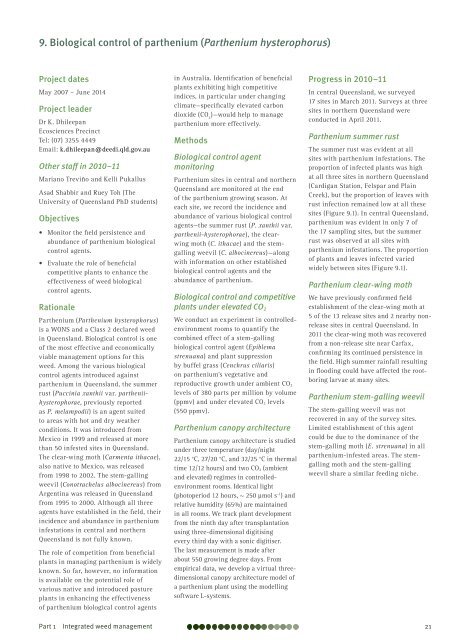Technical highlights - Department of Primary Industries ...
Technical highlights - Department of Primary Industries ...
Technical highlights - Department of Primary Industries ...
Create successful ePaper yourself
Turn your PDF publications into a flip-book with our unique Google optimized e-Paper software.
9. Biological control <strong>of</strong> parthenium (Parthenium hysterophorus)<br />
Project dates<br />
May 2007 – June 2014<br />
Project leader<br />
Dr K. Dhileepan<br />
Ecosciences Precinct<br />
Tel: (07) 3255 4449<br />
Email: k.dhileepan@deedi.qld.gov.au<br />
Other staff in 2010–11<br />
Mariano Treviño and Kelli Pukallus<br />
Asad Shabbir and Ruey Toh (The<br />
University <strong>of</strong> Queensland PhD students)<br />
Objectives<br />
• Monitor the field persistence and<br />
abundance <strong>of</strong> parthenium biological<br />
control agents.<br />
• Evaluate the role <strong>of</strong> beneficial<br />
competitive plants to enhance the<br />
effectiveness <strong>of</strong> weed biological<br />
control agents.<br />
Rationale<br />
Parthenium (Parthenium hysterophorus)<br />
is a WONS and a Class 2 declared weed<br />
in Queensland. Biological control is one<br />
<strong>of</strong> the most effective and economically<br />
viable management options for this<br />
weed. Among the various biological<br />
control agents introduced against<br />
parthenium in Queensland, the summer<br />
rust (Puccinia xanthii var. partheniihysterophorae,<br />
previously reported<br />
as P. melampodii) is an agent suited<br />
to areas with hot and dry weather<br />
conditions. It was introduced from<br />
Mexico in 1999 and released at more<br />
than 50 infested sites in Queensland.<br />
The clear-wing moth (Carmenta ithacae),<br />
also native to Mexico, was released<br />
from 1998 to 2002. The stem-galling<br />
weevil (Conotrachelus albocinereus) from<br />
Argentina was released in Queensland<br />
from 1995 to 2000. Although all three<br />
agents have established in the field, their<br />
incidence and abundance in parthenium<br />
infestations in central and northern<br />
Queensland is not fully known.<br />
The role <strong>of</strong> competition from beneficial<br />
plants in managing parthenium is widely<br />
known. So far, however, no information<br />
is available on the potential role <strong>of</strong><br />
various native and introduced pasture<br />
plants in enhancing the effectiveness<br />
<strong>of</strong> parthenium biological control agents<br />
in Australia. Identification <strong>of</strong> beneficial<br />
plants exhibiting high competitive<br />
indices, in particular under changing<br />
climate—specifically elevated carbon<br />
dioxide (CO 2 )—would help to manage<br />
parthenium more effectively.<br />
Methods<br />
Biological control agent<br />
monitoring<br />
Parthenium sites in central and northern<br />
Queensland are monitored at the end<br />
<strong>of</strong> the parthenium growing season. At<br />
each site, we record the incidence and<br />
abundance <strong>of</strong> various biological control<br />
agents—the summer rust (P. xanthii var.<br />
parthenii-hysterophorae), the clearwing<br />
moth (C. ithacae) and the stemgalling<br />
weevil (C. albocinereus)—along<br />
with information on other established<br />
biological control agents and the<br />
abundance <strong>of</strong> parthenium.<br />
Biological control and competitive<br />
plants under elevated CO2 We conduct an experiment in controlledenvironment<br />
rooms to quantify the<br />
combined effect <strong>of</strong> a stem-galling<br />
biological control agent (Epiblema<br />
strenuana) and plant suppression<br />
by buffel grass (Cenchrus ciliaris)<br />
on parthenium’s vegetative and<br />
reproductive growth under ambient CO2<br />
levels <strong>of</strong> 380 parts per million by volume<br />
(ppmv) and under elevated CO2 levels<br />
(550 ppmv).<br />
Parthenium canopy architecture<br />
Parthenium canopy architecture is studied<br />
under three temperature (day/night<br />
22/15 °C, 27/20 °C, and 32/25 °C in thermal<br />
time 12/12 hours) and two CO2 (ambient<br />
and elevated) regimes in controlledenvironment<br />
rooms. Identical light<br />
(photoperiod 12 hours, ~ 250 μmol s –1 ) and<br />
relative humidity (65%) are maintained<br />
in all rooms. We track plant development<br />
from the ninth day after transplantation<br />
using three-dimensional digitising<br />
every third day with a sonic digitiser.<br />
The last measurement is made after<br />
about 550 growing degree days. From<br />
empirical data, we develop a virtual threedimensional<br />
canopy architecture model <strong>of</strong><br />
a parthenium plant using the modelling<br />
s<strong>of</strong>tware L-systems.<br />
Progress in 2010–11<br />
In central Queensland, we surveyed<br />
17 sites in March 2011. Surveys at three<br />
sites in northern Queensland were<br />
conducted in April 2011.<br />
Parthenium summer rust<br />
The summer rust was evident at all<br />
sites with parthenium infestations. The<br />
proportion <strong>of</strong> infected plants was high<br />
at all three sites in northern Queensland<br />
(Cardigan Station, Felspar and Plain<br />
Creek), but the proportion <strong>of</strong> leaves with<br />
rust infection remained low at all these<br />
sites (Figure 9.1). In central Queensland,<br />
parthenium was evident in only 7 <strong>of</strong><br />
the 17 sampling sites, but the summer<br />
rust was observed at all sites with<br />
parthenium infestations. The proportion<br />
<strong>of</strong> plants and leaves infected varied<br />
widely between sites (Figure 9.1).<br />
Parthenium clear-wing moth<br />
We have previously confirmed field<br />
establishment <strong>of</strong> the clear-wing moth at<br />
5 <strong>of</strong> the 13 release sites and 2 nearby nonrelease<br />
sites in central Queensland. In<br />
2011 the clear-wing moth was recovered<br />
from a non-release site near Carfax,<br />
confirming its continued persistence in<br />
the field. High summer rainfall resulting<br />
in flooding could have affected the rootboring<br />
larvae at many sites.<br />
Parthenium stem-galling weevil<br />
The stem-galling weevil was not<br />
recovered in any <strong>of</strong> the survey sites.<br />
Limited establishment <strong>of</strong> this agent<br />
could be due to the dominance <strong>of</strong> the<br />
stem-galling moth (E. strenuana) in all<br />
parthenium-infested areas. The stemgalling<br />
moth and the stem-galling<br />
weevil share a similar feeding niche.<br />
Part 1 Integrated weed management 21

















